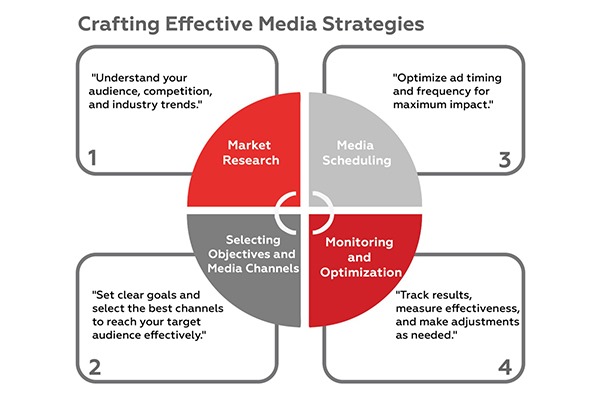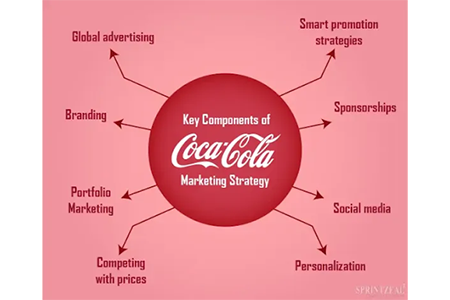Table Of Content
- 1. Introduction
- 2. Understanding Media Planning
- 3. Key Components of Media Planning
- 3.1. Target Audience
- 3.2. Media Mix
- 3.3. Budget Allocation
- 3.4. Timing and Scheduling
- 4. The Media Planning Process
- 4.1. Market Research
- 4.2. Setting Objectives
- 4.3. Selecting Media Channels
- 4.4. Media Scheduling
- 4.5. Monitoring and Optimization
- 5. Benefits of Effective Media Planning
- 6. Challenges in Media Planning
- 6.1. Fragmentation of Media Channels
- 6.2. Ad Clutter
- 6.3. Measuring Effectiveness
- 7. Examples of Successful Media Planning Campaigns
- 8. Conclusion
Introduction
Media planning is the strategic process of designing and implementing a comprehensive media strategy to achieve specific marketing objectives. It involves carefully selecting the most effective combination of media channels, such as television, radio, print, digital, and outdoor advertising, to reach the target audience.
By allocating the budget efficiently and scheduling ads strategically, media planners ensure that marketing efforts are optimized to maximize brand visibility, engagement, and return on investment. A well-executed media plan plays a vital role in driving brand awareness, generating leads, and ultimately achieving business goals.
Understanding Media Planning

Media planning is basically finding the most effective way to allocate marketing resources. It is crucial in marketing strategy because it ensures that advertising efforts are targeted, efficient, and contribute to overall business goals. By understanding the target audience's preferences, behaviors, and media consumption habits, media planners can select the most appropriate channels to reach them. This targeted approach helps businesses avoid wasting resources on ineffective advertising and ensures that every dollar spent delivers maximum impact.
Moreover, effective media planning can optimize advertising budgets by identifying the most cost-effective ways to reach the target audience. By avoiding overspending on underperforming channels and allocating resources strategically, businesses can maximize their return on investment (ROI).
Key Components of Media Planning
Based on the process of efficient media planning, here are the key components that are involved in it.
1. Target Audience
Understanding the demographics, psychographics, and behavior of the target audience is a fundamental step in media planning. This information helps to identify the most effective media channels to reach them.
- Demographics: Age, gender, income, education level, and geographic location are all demographic factors that can influence media consumption habits.
- Psychographics: Lifestyle, interests, values, and attitudes can help to understand the target audience's motivations and preferences.
- Behavior: Media consumption patterns, such as preferred devices, platforms, and times of day, are crucial to consider when selecting media channels.
2. Media Mix
The media mix refers to the combination of media channels used to reach the target audience. The appropriate mix depends on various factors, including:
- Target Audience: The media habits of the target audience will influence the choice of channels. For example, younger audiences may be more likely to engage with digital media, while older audiences may prefer traditional channels like television and radio.
- Budget: The available budget will determine the scale and scope of the media mix. Higher budgets may allow for a broader range of channels, while lower budgets may require a more focused approach.
- Campaign Objectives: The specific goals of the campaign will also influence the media mix. For example, if the objective is to increase brand awareness, a broad reach may be necessary, while if the goal is to drive sales, a more targeted approach may be more effective.
3. Budget Allocation
Efficiently allocating the advertising budget across different media channels is essential to maximize ROI. This involves:
- Prioritizing Channels: Identifying the most effective channels for reaching the target audience and allocating a larger portion of the budget to those channels.
- Considering Costs: Evaluating the costs associated with each media channel, such as production costs, media rates, and agency fees.
- Measuring Effectiveness: Tracking the performance of each media channel to assess its effectiveness and adjust the budget accordingly.
4. Timing and Scheduling
Determining the optimal frequency and timing of ad placements is crucial for maximizing impact and avoiding ad fatigue. Factors to consider include:
- Seasonality: Certain times of year may be more relevant to the product or service being advertised.
- Competitor Activity: Monitoring competitor advertising activity can help to identify peak times and avoid saturation.
- Target Audience Behavior: Understanding when the target audience is most likely to be receptive to advertising can help to optimize scheduling.
The Media Planning Process

1. Market Research
Market research is a critical first step in the media planning process. It involves gathering data to understand the target audience, competition, and industry trends. This information helps to inform the development of a targeted and effective media strategy. It involves the following activities:
- Target Audience Research: Understanding the demographics, psychographics, and media consumption habits of the target audience is essential for selecting the most appropriate media channels.
- Competitive Analysis: Analyzing competitors' media strategies can provide insights into effective approaches and potential pitfalls.
- Industry Trends: Keeping up with industry trends and developments can help to identify emerging opportunities and challenges.
2. Setting Objectives
Clear and measurable campaign objectives are essential for guiding the media planning process. These objectives should align with the overall business goals and provide a framework for evaluating the success of the campaign.
3. Selecting Media Channels
Based on the market research and campaign objectives, media planners can select the most suitable media channels to reach the target audience. This involves considering factors such as:
- Target Audience: The media consumption habits of the target audience will influence the choice of channels.
- Campaign Objectives: The specific goals of the campaign will determine the most appropriate media channels.
- Budget: The available budget will constrain the options and require careful prioritization.
- Channel Effectiveness: Evaluating the effectiveness of different media channels in reaching the target audience and achieving the campaign objectives is essential.
4. Media Scheduling
Media scheduling involves developing a timeline for when and where ads will be displayed to optimize reach and frequency. Factors to consider include:
- Seasonality: Certain times of year may be more relevant to the product or service being advertised.
- Competitor Activity: Monitoring competitor advertising activity can help to identify peak times and avoid saturation.
- Target Audience Behavior: Understanding when the target audience is most likely to be receptive to advertising can help to optimize scheduling.
- Flighting: Determining the frequency and duration of ad placements to ensure maximum impact and avoid ad fatigue.
5. Monitoring and Optimization
Once the media plan is implemented, it is essential to monitor its performance and make adjustments as needed. This involves tracking key metrics such as:
- Reach: The number of people exposed to the advertising message.
- Frequency: The average number of times an individual is exposed to the advertising message.
- Impression: The number of times an ad is displayed.
- Click-through Rate (CTR): The percentage of people who click on an online ad.
- Conversion Rate: The percentage of people who take a desired action, such as making a purchase or signing up for a newsletter.
By analyzing these metrics, media planners can identify areas for improvement and optimize the media plan to achieve maximum effectiveness.
Benefits of Effective Media Planning
1. Maximized ROI
A well-planned media strategy is essential for maximizing return on investment (ROI). By carefully selecting the most effective media channels, allocating the budget efficiently, and scheduling ads strategically, businesses can ensure that every dollar spent delivers maximum impact. This can lead to:
- Increased Sales: Effective media planning can drive sales by reaching the right audience at the right time with the right message.
- Improved Lead Generation: By targeting potential customers with relevant advertising, businesses can generate more leads and opportunities for conversion.
- Enhanced Customer Engagement: Well-planned media campaigns can increase brand awareness and engagement, fostering loyalty and repeat business.
2. Increased Brand Awareness
Effective media planning can significantly enhance brand visibility and recognition. By strategically placing ads across various media channels, businesses can increase their brand's exposure to the target audience. This can lead to:
- Improved Brand Recall
- Enhanced Brand Image
- Increased Market Share
3. Efficient Resource Allocation
Properly distributing resources across multiple media channels is essential for optimizing the budget and preventing wasted spending. Effective media planning involves strategically identifying the most effective channels, allocating resources, and monitoring performance.
4. Improved Campaign Performance
A well-planned media strategy can significantly improve the overall success of marketing campaigns. By understanding the target audience, selecting the most effective media channels, and scheduling ads strategically, businesses can:
- Increase Campaign Effectiveness: A well-planned media strategy can ensure that advertising efforts are targeted, relevant, and impactful.
- Reduce Costs: By avoiding wasted spending on ineffective media channels, businesses can reduce overall campaign costs.
- Achieve Campaign Objectives: A well-planned media strategy can help businesses achieve their campaign objectives, whether it's increasing sales, generating leads, or building brand awareness.
Challenges in Media Planning
1. Fragmentation of Media Channels
The increasing number of media channels, especially digital platforms, has led to a fragmented media landscape. This makes it challenging for businesses to reach their target audience effectively and efficiently. The proliferation of channels can result in ad clutter, making it difficult for brands to stand out.
2. Ad Clutter
The abundance of advertising across various media channels can create a cluttered environment, making it difficult for brands to cut through the noise and capture attention. This can lead to decreased ad effectiveness and higher costs per impression.
3. Measuring Effectiveness
Accurately measuring the effectiveness of media efforts can be challenging, especially in the digital age. The complexity of tracking metrics across multiple channels and devices can make it difficult to determine the true impact of advertising campaigns. This can hinder businesses' ability to optimize their media strategies and maximize ROI.
Examples of Successful Media Planning Campaigns
1. Coca-Cola’s Media Mix Strategy

Coca-Cola is a prime example of a brand that has successfully leveraged a diverse media mix to maintain its iconic brand status. The company's media strategy incorporates a variety of channels, including:
- Television: Coca-Cola has long been associated with iconic television commercials that have become cultural touchstones. These commercials often feature heartwarming stories, catchy jingles, and visually appealing imagery.
- Print Advertising: Coca-Cola has also utilized print advertising in magazines and newspapers to reach a wider audience and reinforce its brand message.
- Digital Marketing: Coca-Cola has embraced digital marketing channels, including social media, content marketing, and email marketing, to connect with younger generations and drive engagement.
- Experiential Marketing: Coca-Cola is known for its innovative experiential marketing campaigns, such as the "Share a Coke" campaign, which encouraged consumers to personalize their Coke bottles with their names or the names of friends.
By combining these various media channels, Coca-Cola has been able to reach a broad audience, reinforce its brand message, and maintain its iconic status.
2. Nike’s Digital-First Approach

Nike is another example of a brand that has successfully leveraged media planning to achieve its marketing goals. The company has adopted a digital-first approach, focusing on digital marketing channels to connect with younger generations and drive engagement. Nike's digital strategy includes:
- Social Media: Nike is highly active on social media platforms, using them to share product news, athlete highlights, and inspirational content. The company has also collaborated with influencers and athletes to create engaging content and build a strong online community.
- Content Marketing: Nike produces high-quality content, such as athlete profiles, training tips, and behind-the-scenes footage, to engage its audience and position the brand as a leader in the sports industry.
- Digital Advertising: Nike uses targeted digital advertising, including display ads, video ads, and social media advertising, to reach specific segments of its target audience.
By focusing on digital marketing channels, Nike has been able to connect with a younger audience, drive engagement, and reinforce its brand as a leader in the sports industry.
Conclusion
Effective media planning is crucial for marketing success. By grasping the key components, following a strategic process, and overcoming challenges, businesses can craft targeted and impactful media strategies. To ensure your media planning is top-notch and drives brand awareness, engagement, and sales, partner with our advertising agency today!



